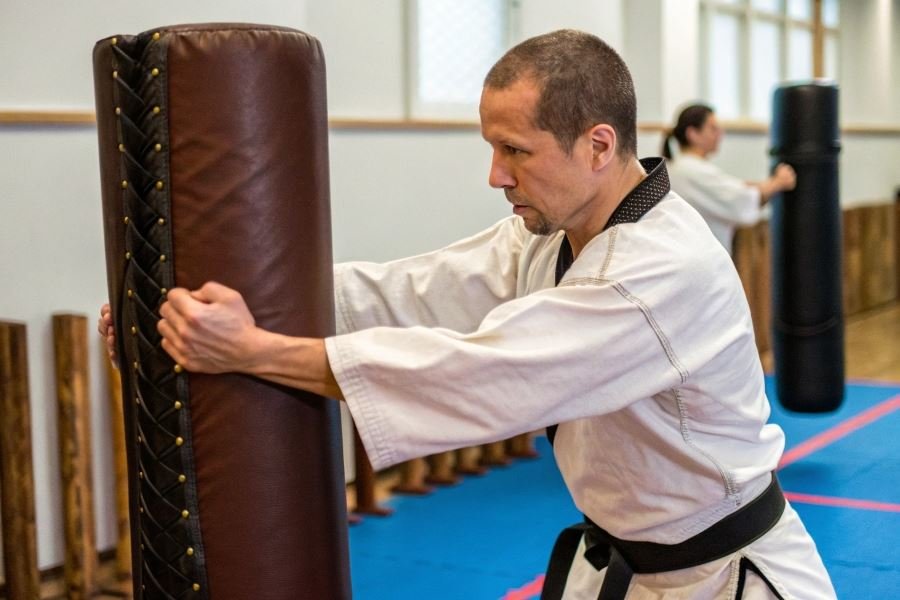
Ever watched a karate master shatter a board with a single strike and wondered how they developed that power? The secret often lies with an ancient training tool that has shaped martial arts legends for centuries.
The makiwara—literally “wrapped board” in Japanese—stands as one of martial arts’ most enduring training devices. Dating back to Okinawan karate’s formative period in the 18th century, this deceptively simple striking post has been the silent partner in developing some of history’s most formidable fighters. Unlike modern punching bags, the makiwara doesn’t swing away from your force—it absorbs and returns it, teaching your body to generate power through proper alignment rather than momentum.
Selecting the right makiwara for your training journey isn’t just about buying equipment; it’s about understanding your developmental needs as a martial artist. The resistance, height, and mounting style should evolve alongside your skills, preventing both frustration and injury while maximizing growth.
Types of makiwara for every training environment
Traditional post-style makiwara features a tapered wooden board planted firmly in the ground, offering the authentic experience preferred by purists. The wall-mounted version provides similar benefits with less space requirement, making it ideal for home dojos. For travelers and apartment dwellers, portable makiwara options deliver surprising effectiveness despite their compact design.
Your training level dictates which style serves you best. Beginners benefit from softer, more forgiving surfaces, while advanced practitioners require the unyielding feedback that only traditional hardwood can provide. The perfect makiwara grows with you, challenging you precisely when you’re ready for the next level.
Matching Your Makiwara to Your Martial Arts Journey
The ancient training tool that has toughened the hands of karate masters for centuries isn’t one-size-fits-all. Selecting the right makiwara based on your training level can mean the difference between proper technique development and unnecessary injury. Let’s break down how to choose a makiwara according to your level of training, ensuring you get the most benefit while minimizing risk.
Beginner Foundations
For those just beginning their striking journey, your makiwara selection should prioritize safety and proper form development:
Padding is your friend – Look for models with substantial foam or leather padding (at least 1-inch thickness) to protect your knuckles while they toughen naturally. The Shureido Beginner Makiwara offers excellent cushioning without sacrificing feedback.
Height adjustment capabilities are non-negotiable for beginners. Your striking surface should align precisely with your middle knuckle when standing in natural position. Too high or low, and you’re programming improper technique into muscle memory.
Resistance levels should start lower – approximately 10-15 pounds of pressure to achieve 1-inch displacement. This allows for:
- Development of proper alignment
- Focus on technique rather than power
- Gradual conditioning of striking surfaces
A beginner’s makiwara should bend like a young sapling, not an ancient oak.
Intermediate Requirements
As your technique refines and your body adapts, your makiwara needs evolve:
Moderate resistance becomes essential – Look for boards that require 20-30 pounds of pressure for proper displacement. The Kamikaze Mid-Level Training Board offers this sweet spot of resistance.
Durability factors now take center stage. Intermediate practitioners typically increase both volume and intensity, demanding:
| Feature | Recommendation |
|---|---|
| Board Material | Tapered white oak or hickory |
| Mounting | Concrete base or deeply buried (3+ feet) |
| Padding | 1/2-inch medium-density leather |
| Expected Lifespan | 2-3 years of regular use |
Technique refinement capabilities become crucial at this stage. Your makiwara should provide clear feedback on strike placement, alignment, and follow-through. Many intermediate practitioners benefit from boards with target zones or pressure-sensitive striking surfaces.
Advanced Selection Criteria
For the seasoned striker, the makiwara becomes less a training tool and more an extension of your practice:
Minimal padding – Advanced practitioners typically prefer just 1/4-inch leather or even bare wood for maximum feedback and conditioning. The Tokaido Professional Makiwara exemplifies this minimalist approach.
Specialized striking surfaces allow for targeted development:
- Textured surfaces for nukite (spear hand) training
- Angled boards for shuto (knife hand) strikes
- Variable resistance zones for combination work
Customization options become paramount at this level. Consider:
- Adjustable resistance mechanisms
- Interchangeable striking surfaces
- Portable designs for travel training
Advanced practitioners should look for boards requiring 35+ pounds of pressure for displacement, creating the resistance necessary to develop explosive power without sacrificing technique.
Remember that even at advanced levels, your makiwara should never be so rigid that it causes joint damage. The goal remains perfect technique with maximum power transfer, not injury accumulation disguised as toughness.
Maximizing Your Makiwara Journey
Extending the life of your striking partner
The relationship between a karateka and their makiwara is sacred—and like any meaningful relationship, proper maintenance is essential. A well-maintained makiwara can serve you faithfully for years, even decades.
Start with regular inspection. After each training session, check for splinters, cracks, or loosening at the base. These small issues can quickly become major problems if ignored. For wooden makiwaras, apply a light coat of tung oil every 3-4 months to prevent drying and cracking—especially important in dry climates.
The striking surface deserves special attention. If you’re using a traditional rope-wrapped makiwara, rewrap it when you notice significant wear. For padded versions, clean the striking surface with a damp cloth and mild soap to remove sweat and oils that can degrade materials over time.
Maintenance isn’t just about longevity—it’s about consistent training feedback. A neglected makiwara changes its response characteristics, compromising your technique development.
For outdoor makiwaras, consider a weather-resistant cover during extreme conditions. The freeze-thaw cycle can be particularly damaging to wooden posts embedded in the ground.
Evolving with your striking skills
Your first makiwara shouldn’t be your last. As your skills develop, your training tools should evolve alongside you.
Beginner to intermediate transition signs:
- Your strikes no longer cause the makiwara to bend significantly
- Recovery time between sessions has shortened dramatically
- You can maintain proper form throughout longer training sessions
When these signs appear, it’s time to consider a stiffer board or post. This progression isn’t just about increasing resistance—it’s about continuing to challenge your body to adapt.
For those transitioning to advanced training, consider specialized makiwaras with different striking surfaces. Some advanced practitioners maintain multiple makiwaras—perhaps a traditional wooden post for foundational work and a specialized version for particular techniques.
Elite makiwara options across skill levels
| Training Level | Recommended Product | Key Features |
|---|---|---|
| Beginner | Shureido Wall Makiwara | Adjustable tension, padded striking surface, ideal for apartment dwellers |
| Intermediate | Kamikaze Professional Makiwara | Traditional design, premium hardwood, excellent rebound characteristics |
| Advanced | Tokaido Competition Makiwara | Ultra-durable construction, multiple striking surfaces, customizable resistance |
For beginners, the Shureido Wall Makiwara offers forgiving feedback while teaching proper technique. Its adjustable tension allows gradual progression without overwhelming new practitioners.
Intermediate students benefit from the Kamikaze Professional’s authentic feel and consistent response. The premium hardwood construction mimics traditional dojo equipment while providing reliable feedback for developing power.
Advanced practitioners will appreciate the Tokaido Competition Makiwara’s versatility. Its multiple striking surfaces allow specialized training for different techniques, while the customizable resistance settings accommodate various training goals—from speed work to maximum power development.
Remember that progression isn’t linear. Many advanced practitioners return to softer makiwaras for recovery sessions or technique refinement. The goal isn’t always more resistance—it’s the right resistance for your current training objectives.
